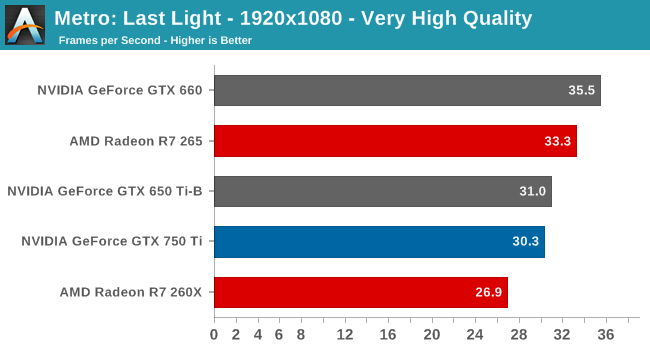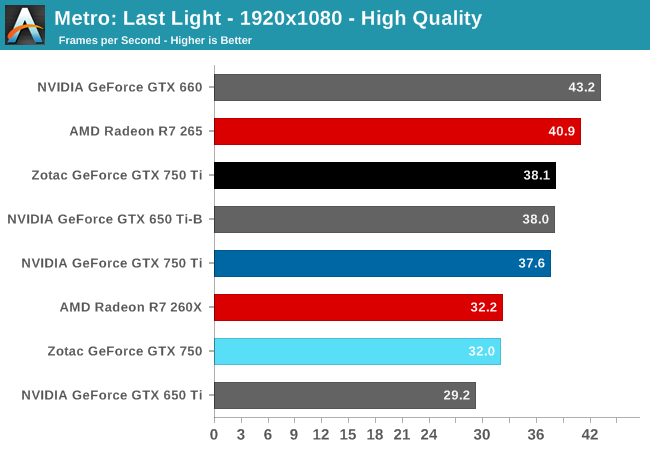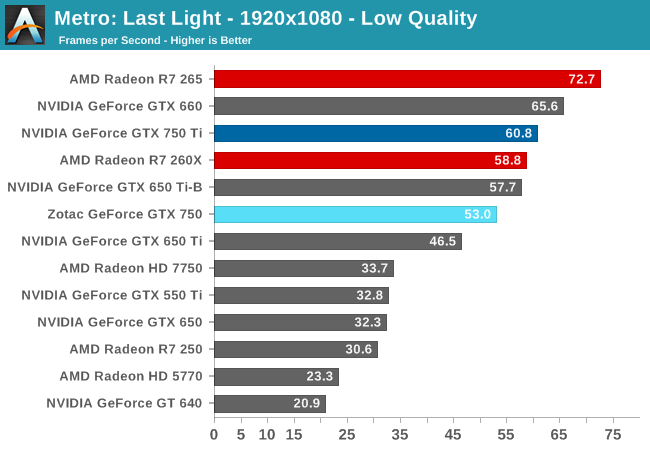The NVIDIA GeForce GTX 750 Ti and GTX 750 Review: Maxwell Makes Its Move
by Ryan Smith & Ganesh T S on February 18, 2014 9:00 AM ESTMetro: Last Light
As always, kicking off our look at performance is 4A Games’ latest entry in their Metro series of subterranean shooters, Metro: Last Light. The original Metro: 2033 was a graphically punishing game for its time and Metro: Last Light is in its own right too. On the other hand it scales well with resolution and quality settings, so it’s still playable on lower end hardware.



Diving into our performance analysis, we’ll be looking at a few different factors. On a competitive basis, the GTX 660 and the R7 265 are the GTX 750 Ti’s closest competitors. Though we’ll also want to compare it to GTX 650, so see what a GK107 versus GM107 matchup looks like. Meanwhile the GTX 750’s closest competitors will be the R7 260X, and to a lesser degree the GTX 650 Ti.
Being one of our more difficult games, Metro shows right off the bat that these mainstream video cards, no matter how fast they are, will face a difficult time. The GTX 750 Ti can stay comfortably above the 30fps at high quality, but the GTX 750 not so much.
What’s clear right off the bat two is two things. The first is that GTX 750 Ti, the GM107 flagship, is significantly faster than GTX 650, the GK107 flagship. GTX 750 Ti is just short of doubling GTX 650’s performance in this benchmark.
The second point is that neither GTX 750 series card is going to fare well against its AMD counterpart. Both the R7 265 and R7 260 are faster than the GeForce cards, and by over 10% at times.
Finally, GTX 750 Ti won’t be touching GTX 660 here. It’s close, but especially at higher quality settings the GTX 660 is pulling away. GTX 750 Ti can’t completely make up for the lack of memory bandwidth and ROP throughput.










177 Comments
View All Comments
dylan522p - Tuesday, February 18, 2014 - link
They are waiting for 20nm for the entire 800 series .MugatoPdub - Tuesday, February 18, 2014 - link
Interestingly, it seems Nvidia has simply followed Intel in the "mobile first" market race, it is starting to feel as if the enthusiast will be left in the dust within the next few years =(Krysto - Tuesday, February 18, 2014 - link
Not likely, thanks to the boom in VR that we'll be seeing, which at 4k and 120fps games, will require 16x the performance we get now for games, just to play the same games, in a few years.So if anything, Nvidia should be making GPU's at the high-end that are a level or two ABOVE Titan (think 20-30 TF GPUs in 2015).
A5 - Tuesday, February 18, 2014 - link
They probably will? I'm guessing we won't see stuff below the top end (or SLI) targeted at 4K until late 2015/spring 2016, though.madmilk - Tuesday, February 18, 2014 - link
I doubt enthusiasts will be left behind, simply because HPC users will demand a 225W Tesla card. That in turn can easily sold as a 250W enthusiast card, perhaps under the Titan line.Mondozai - Wednesday, February 19, 2014 - link
Also, Nvidias desktop business is contributing to their profits and is seeing revenue growth. Their Tegra business revenue is falling almost 50% year over year.The desktop high-end GPU market will grow in good health for years to come. Their discrete laptop GPUs, however, will face doom in a relativeley short period of time as integrated GPUs performance rises to a level when most people are satisfied. Laptops specifically for gaming continues to be an unsignificant market.
jkauff - Tuesday, February 18, 2014 - link
madVR NNEDI3 uses OpenCL, and works fine on Intel and AMD boards. NVIDIA OpenCL support has been broken for the last couple of driver iterations. Please use your influence with the NVIDIA developers to get this fixed in the next driver release.IKeelU - Tuesday, February 18, 2014 - link
ugh, cryptocointexasti89 - Tuesday, February 18, 2014 - link
Wow! .. Substantially faster than 260x and consuming less than 60w using same process node. Really impressive. I can't wait to see how Maxwell arch performance & power scale at 20nm. I'm really convinced now that AMD GCN is not as efficient as many reviewers think. AMD will very likely have a hard time in this round.g101 - Tuesday, February 18, 2014 - link
*slower...Almost always slower than the 260x.... , all for power savings in the range of 5-10%...How...exciting?You should try reading the actual words that have been written in the article.